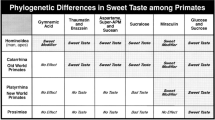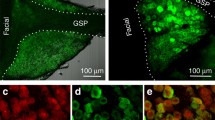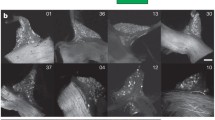Summary
A total of 311 units, responsive to natural stimulation of the oral cavity, were isolated from the rostral part of the solitary tract nucleus (NTS) of rats. Of these, 169 “taste neurons”, activated by taste stimulation, and 142 mechanoreceptive units, exclusively sensitive to mechanical stimulation of the oral cavity, were found. Most taste units (62.3%) were also excited by mechanical stimulation. Forty-three (34.1%) of the 126 taste units examined were identified as solitario-parabrachial relay (SP) neurons by antidromic stimulation from the ipsilateral dorsal pons, while only eleven (12.6%) of the 87 mechanoreceptive units were SP neurons. Taste SP neurons could be divided into two subgroups according to their antidromic latency; the fast SP units with an antidromic latency shorter than 9 ms and slow SP units with a longer antidromic latency. These two subgroups were not differentiated in any physiological properties except that the fast SP neurons were frequently excited by sucrose. Taste neurons were classified according to the best stimulus of the four basic taste solutions to produce the largest number of discharges in each neuron. All types of taste neurons were found among the SP and non-SP neurons, but only a small number of quinine-best neurons (n = 2) were found in the SP neuron group compared to the number of quinine-best neurons in the non-SP neuron group (n = 10). A histological examination of the recording sites revealed that taste relay neurons were found at the central or dorsal part of the nucleus but mechanoreceptive relay neurons were found at the peripheral part, although relay and non-relay neurons of either class were intermingled in the nucleus.
Similar content being viewed by others
References
Bishop PO, Burke W, Davis R (1962) The identification of single units in central visual pathways. J Physiol (Lond) 162: 409–431
Doetsch GS, Erickson RP (1970) Synaptic processing of taste-quality information in the nucleus tractus solitarius of the rat. J Neurophysiol 33: 490–507
Erickson RP (1963) Sensory neural patterns and gustation. In: Zotterman Y (ed) Olfaction and taste. Pergamon, Oxford, pp 205–213
Frank M (1973) An analysis of hamster afferent taste nerve response functions. J Gen Physiol 61: 588–618
Fukushima T, Kerr FWL (1979) Organization of trigeminothalamic tracts and other thalamic afferent systems of the brainstem in the rat: Presence of gelatinosa neurons with thalamic connections. J Comp Neurol 183: 169–184
Fuller JH, Schlag JD (1976) Determination of antidromic excitation by the collision test: Problems of interpretation. Brain Res 112: 283–298
Ganchrow JR, Erickson RP (1970) Neural correlates of gustatory intensity and quality. J Neurophysiol 33: 768–783
Grill HJ, Norgren R (1978) The taste reactivity test. I. Mimetic responses to gustatory stimuli in neurologically normal rats. Brain Res 143: 263–279
Halpern BP, Nelson LM (1965) Bulbar gustatory responses to anterior and to posterior tongue stimulation in the rat. Am J Physiol 209: 105–110
Makous W, Nord S, Oakley B, Pfaffman C (1963) The gustatory relay in the medulla. In: Zotterman Y (ed) Olfaction and taste. Pergamon, Oxford, pp 381–393
Norgren R (1978) Projections from the nucleus of the solitary tract in the rat. Neurosci 3: 207–218
Norgren R, Leonard C (1973) Ascending central gustatory pathways. J Comp Neurol 150: 217–237
Norgren R, Pfaffmann C (1975) The pontine taste area in the rat. Brain Res 91: 99–117
Ogawa H, Akagi T, Ito H, Imoto T (1979) Lingual projections to the dorsal pons of the rats, studied by the field potential analysis. Neurosci Lett 12: 289–293
Ogawa H, Hayama T Receptive fields of solitario-parabrachial relay neurons responsive to natural stimulation of the oral cavity in rats. (An accompanying paper)
Ogawa H, Hayama T, Ito S (1982) Convergence of input from tongue and palate to the parabrachial nucleus neurons of rats. Neurosci Lett 28: 9–14
Ogawa H, Imoto T, Hayama T (1980) Taste relay neurons in the solitary tract nucleus of rats. Neurosci Lett 18: 295–299
Ogawa H, Imoto T, Hayama T, Kaisaku J (1981) Afferent connections to the pontine taste area: Physiologic and anatomic studies. In: Katsuki Y, Norgren R, Sato M (eds) Brain mechanisms of sensation. Wiley, New York, pp 161–175
Ogawa H, Kaisaku J (1982) Physiological characteristics of the solitario-parabrachial relay neurons with tongue afferent inputs in rats. Exp Brain Res 48: 362–368
Ogawa H, Sato M, Yamashita S (1968) Multiple sensitivity of chorda tympani fibers of the rat and hamster to gustatory and thermal stimuli. J Physiol 199: 223–240
Ricardo JA, Koh ET (1978) Anatomical evidence of direct projections from the nucleus of the solitary tract to the hypothalamus, amygdala, and other forebrain structures in the rat. Brain Res 153: 1–20
Sato M (1975) Response characteristics of taste nerve fibers in macaque monkey: Comparison with those in rats and hamsters. In: Denton DA, Coghlan JP (eds) Olfaction and taste V. Academic Press, New York, pp 23–26
Torvik A (1956) Afferent connections to the sensory trigeminal nuclei, the nucleus of the solitary tract and adjacent structures. An experimental study in the rat. J Comp Neurol 106: 51–141
Travers JB, Smith DV (1979) Gustatory sensitivities in neurons of the hamster nucleus tractus solitarius. Sensory Processes 3: 1–26
Woolston DC, Erickson RP (1979) Concept of neuron types in gustation in the rat. J Neurophysiol 42: 1390–1409
Author information
Authors and Affiliations
Additional information
Supported by a Grant from the Ministry of Education, Science and Culture of Japan (No. 58106008)
Rights and permissions
About this article
Cite this article
Ogawa, H., Imoto, T. & Hayama, T. Responsiveness of solitario-parabrachial relay neurons to taste and mechanical stimulation applied to the oral cavity in rats. Exp Brain Res 54, 349–358 (1984). https://doi.org/10.1007/BF00236236
Received:
Issue Date:
DOI: https://doi.org/10.1007/BF00236236




